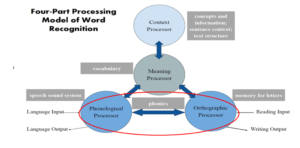Researcher Wiley Blevins in his book, Phonics from A to Z, says that Phonemic Awareness and Phonics enjoy a reciprocal relationship (2017). Phonemic awareness provides the foundation on which phonics instruction is built. Thus, children need solid phonemic awareness training for phonics instruction to be effective.
The neural pathways between the phonological processer and orthographic processor are built through phonics instruction (see diagram below)

In a Phonics lessons, students are making connections between the sounds (Phonemes) and the letter/ letter combinations (graphemes) to represent those sounds.
For example: If I say the word ‘book’ What is the first sound you hear? The students will respond ‘/b/’!
But, as soon as I say everyone show me what the letter /b/ looks like it becomes a phonics activity. (Blevins 2017).
Letters vs. phonemes – What Should We Teach First?
Many children come to school familiar with the ABC song and these children will already know some or all letter names. The Rose Review (2006) states that it is “sensible to teach both names and sounds of letters”. Once these have been learned, children can add more complex digraphs (such as sh, ch), trigraphs (such as tch, dge) and quadgraphs (such as eigh, ough). (Five from Five, 2025. Excerpt from Teaching Grapheme- Phoneme Correspondences, Five from five.com.au/phonics).
As all early year’s teachers will tell you, children come to school with varied understandings of letters, speech sounds and consequently confusion about both.
There are two main approaches that teachers use to help children make connections between speech and print. Some start with print and connect speech (Print to Speech), others advocate teaching from the opposite direction (Speech to Print).
However, how researchers and teachers approach learning to read differs, the science seems to still be inconclusive about which approach is best. As referred to in the above quote about the findings of ‘The Rose Review’, I do not think we should delay one for the other. Delaying the teaching of letter sound connections until all letter names established, does not work with the demands of the classrooms of today, nor does it support the varied needs of all students in your classroom.
How your school approaches this is a school-based decision, as is the program that they choose to scaffold teaching.
I have attached a links to both Tim Shanahan’s blog, and Five from Five’s website for you to explore this further (see below).
Listen to Dr. Louisa Moats explains to a kindergarten teacher why it is critical to differentiate between the letters and sounds within a word when teaching children to read and write.
Now listen to Linda Farrell demonstrate how to support a student who have difficulty with letter names.
What I like about this video is Linda’s intervention approach to a problem that we all see in the early years. https://youtu.be/VKN3oJVBvEw?si=9C2-QDB6K6cUWYQc
Links to Further Learning
Teaching grapheme-phoneme correspondences – Five from Five
Letter Names or Sounds First? | Shanahan on Literacy
Phonological and Phonemic Awareness: Introduction | Reading Rockets
Teaching grapheme-phoneme correspondences – Five from Five
